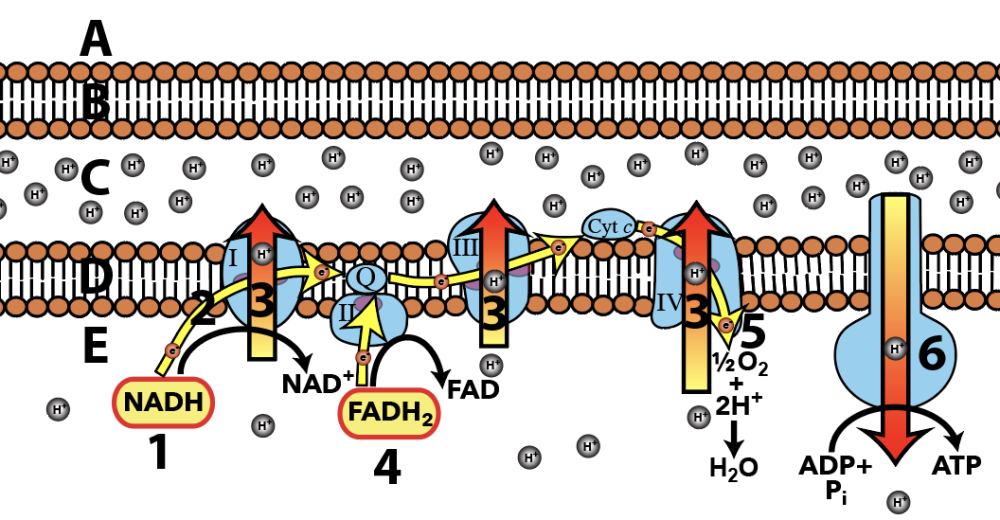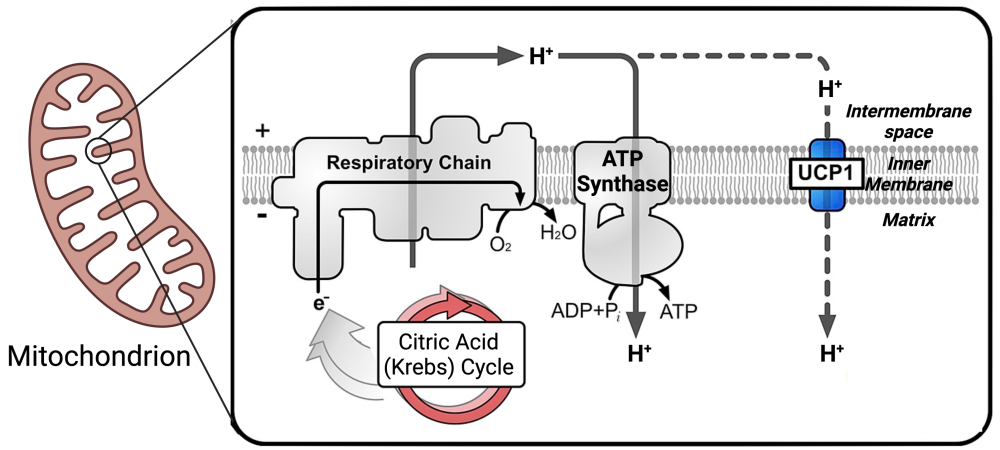1. Watch these Videos
1.a. Finally Understand the Electron Transport Chain and Chemiosmosis!
1.b. Mysteries of the Electron Transport Chain, Revealed in Rap!
2. Study this Summary
How the Electron Transport Chain Generates ATP

A-cytoplasm; B-mitochondrial outer membrane; C-intermembrane space; D-inner membrane;
E-matrix; 1-NADH; 2-Electron transport chain; 3-proton pump; 4-FADH₂;
5-Oxygen (final electron acceptor); 6-ATP synthase
- Where this happens
- The mitochondrial inner membrane and the intermembrane space.
- The inner membrane is highly folded, and adaptation that increases the surface area for the enzymes and proteins involved in the electron transport chain and chemiosmosis.
- Overview of Inputs:
- Electron carriers NADH and FADH₂, produced in glycolysis, the link reaction, and the Krebs cycle, diffuse into the mitochondrial matrix and deliver electrons to the ETC.
- Oxidation occurs: NADH and FADH₂ lose electrons, which flow through the ETC (a series of proteins embedded in the inner mitochondrial membrane).
- Electron Flow and Proton Gradient:
- Electrons move through the ETC, creating an electrical current.
- Some ETC proteins are proton pumps that actively transport protons (H⁺) from the matrix to the intermembrane space, using energy from electron flow.
- This creates:
- An electrochemical gradient: High H⁺ concentration and positive charge in the intermembrane space, low in the matrix.
- A pH gradient: Lower pH in the intermembrane space (caused by the accumulation of protons in that area)
- Role of Oxygen:
- Oxygen is the final electron acceptor, pulling electrons down the chain due to its high electronegativity.
- Oxygen combines with electrons and protons in the matrix to form water, enhancing the gradient by removing protons from the matrix.
- ATP Synthesis:
- Protons can only diffuse back into the matrix through ATP synthase, a channel and an enzyme.
- This is facilitated diffusion, and the kinetic energy of protons powers the phosphorylation of ADP an Pi (inorganic phosphate) to ATP.
- Chemiosmosis is the term used to describe the flow of protons through ATP synthase to create ATP
- The entire process is known as oxidative phosphorylation.
How the ETC is Used for Generating Heat Instead of ATP

Using the uncoupling channel (or UCP), the electron transport chain can be used to create heat instead of ATP.
- Where this happens
- In Brown Fat Cells, which are found in newborns, hibernating mammals, and other mammals that need heat regulation.
- Mechanism:
- A protein channel called thermogenin (or UCP, the uncoupling protein) forms in the inner mitochondrial membrane.
- Protons bypass ATP synthase, diffusing back into the matrix without generating ATP.
- The electron transport chain still operates, and the flow of electrons generates heat through resistance, much like electricity flowing through a wire.
3. Master these Flashcards
[qdeck style=”width: 600px !important; min-height: 450px !important;” bold_text=”false” random=”true” qrecord_id=”sciencemusicvideosMeister1961-Electron Transport Chain Flashcards, APBVP”]
[h]The Electron Transport Chain and Chemiosmosis
[i]
[q json=”true” yy=”4″ unit=”3.Cellular_Energetics” dataset_id=”AP_Bio_Flashcards_2022|1c3b3b937e910″ question_number=”123″ topic=”3.6.Cellular_Respiration”] Connect the structure and function of mitochondria to cellular respiration and ATP synthesis.
[a] Mitochondria are double-membraned organelles. The highly folded inner membrane (2) increases the surface area for the membrane-embedded proteins that make up the mitochondrial electron transport chain, as well as the ATP synthase channel. The intermembrane space provides a compartment into which protons can be pumped, creating the chemiosmotic gradient that powers ATP synthesis.
[q json=”true” yy=”4″ unit=”3.Cellular_Energetics” dataset_id=”AP_Bio_Flashcards_2022|1c21c45170d10″ question_number=”126″ topic=”3.6.Cellular_Respiration”] Explain how the mitochondrial electron transport chain generates ATP.
[a]
The ETC starts by oxidizing electrons from NADH and FADH2 (1 and 4). The liberated electrons flow through a series of membrane-embedded proteins on the mitochondrial inner membrane. Some of these (3) pump protons from the matrix (E) to the intermembrane space (C), creating an electrochemical gradient. Facilitated diffusion through the ATP synthase channel back to the the matrix powers formation of ATP from ADP and Pi.
[q json=”true” yy=”4″ unit=”3.Cellular_Energetics” dataset_id=”AP_Bio_Flashcards_2022|1c10bdba7d910″ question_number=”127″ topic=”3.6.Cellular_Respiration”] Cellular respiration can be used to generate heat instead of ATP. Explain.
[a] During non-shivering thermogenesis, the flow of electrons along the ETC generates heat: just imagine electricity flowing through the high-resistance wires in a toaster, and you’ll have the idea.
Newborn and hibernating mammals have brown fat, the cells of which are dense with mitochondria (which is why it’s brown). When the animal needs to generate body heat, hormonal signals induce a proton channel called thermogenin or UCP (for uncoupling channel) to form in the inner mitochondrial membrane. This channel lets protons diffuse back to the matrix from the intermembrane space without passing through ATP synthase. Thus, heat is created, but not ATP.
[q json=”true” yy=”4″ unit=”3.Cellular_Energetics” dataset_id=”AP_Bio_Flashcards_2022|1d4b4c937e910″ question_number=”128″ topic=”3.6.Cellular_Respiration”] Why do NADH and FADH2 enter the electron transport chain at different points?
[a]
NADH enters the ETC at the first protein complex, while FADH2 enters later in the chain. This is because NADH carries higher-energy electrons compared to FADH2, allowing it to contribute more energy to proton pumping and ATP synthesis.
[q json=”true” yy=”4″ unit=”3.Cellular_Energetics” dataset_id=”AP_Bio_Flashcards_2022|1e4b4c937e910″ question_number=”129″ topic=”3.6.Cellular_Respiration”] How does the electron transport chain create a proton gradient?
[a]
The ETC pumps protons (H+) from the mitochondrial matrix into the intermembrane space using energy from electron flow. This process creates a high concentration of protons in the intermembrane space and a low concentration in the matrix, forming an electrochemical gradient.
[q json=”true” yy=”4″ unit=”3.Cellular_Energetics” dataset_id=”AP_Bio_Flashcards_2022|1f4b4c937e910″ question_number=”130″ topic=”3.6.Cellular_Respiration”] Why is oxygen essential for the electron transport chain?
[a]
Oxygen acts as the final electron acceptor in the ETC. Its high electronegativity pulls electrons through the chain. At the end of the chain, oxygen combines with electrons and protons to form water, maintaining the flow of electrons and proton pumping.
[q json=”true” yy=”4″ unit=”3.Cellular_Energetics” dataset_id=”AP_Bio_Flashcards_2022|1g4b4c937e910″ question_number=”131″ topic=”3.6.Cellular_Respiration”] What is chemiosmosis, and how does it generate ATP?
[a]
Chemiosmosis refers to the movement of protons (H+) down their electrochemical gradient through ATP synthase. This facilitated diffusion releases energy, which ATP synthase uses to phosphorylate ADP into ATP.
[q json=”true” yy=”4″ unit=”3.Cellular_Energetics” dataset_id=”AP_Bio_Flashcards_2022|1h4b4c937e910″ question_number=”132″ topic=”3.6.Cellular_Respiration”] How does the proton gradient created by the ETC affect pH in different mitochondrial compartments?
[a]
The intermembrane space has a lower pH due to a high concentration of protons (H+), making it more acidic. The matrix has a higher pH because it has fewer protons, making it more basic.
[/qdeck]
4. Tackle these Quizzes
4.1. Mitochondrial Structure and ATP Synthesis
[qwiz qrecord_id=”sciencemusicvideosMeister1961-Mitochondrial Structure and ATP Synthesis, APBVP”]
[h]Mitochondrial Structure and ATP Synthesis
[i]
[q labels = “top”]
[l]cell exterior
[f*] Excellent!
[fx] No, that’s not correct. Please try again.
[l]cell membrane
[f*] Excellent!
[fx] No. Please try again.
[l]cytoplasm
[f*] Excellent!
[fx] No, that’s not correct. Please try again.
[l]inner membrane
[f*] Good!
[fx] No. Please try again.
[l]intermembrane space
[f*] Good!
[fx] No, that’s not correct. Please try again.
[l]matrix
[f*] Excellent!
[fx] No, that’s not correct. Please try again.
[l]mitochondrion
[f*] Correct!
[fx] No. Please try again.
[l]outer membrane
[f*] Correct!
[fx] No. Please try again.
[q labels = “top”]
[l]ATP Synthase
[f*] Excellent!
[fx] No, that’s not correct. Please try again.
[l]chromosome
[f*] Great!
[fx] No. Please try again.
[l]cytoplasm
[f*] Good!
[fx] No, that’s not correct. Please try again.
[l]inner membrane
[f*] Great!
[fx] No, that’s not correct. Please try again.
[l]intermembrane space
[f*] Excellent!
[fx] No. Please try again.
[l]matrix
[f*] Good!
[fx] No. Please try again.
[l]outer membrane
[f*] Great!
[fx] No, that’s not correct. Please try again.
[q]Which letter is the inner membrane?
[textentry single_char=”true”]
[c]IE Q=
[f]IEV4Y2VsbGVudC4gJiM4MjIwO0QmIzgyMjE7IGlzIHRoZSBpbm5lciBtaXRvY2hvbmRyaWFsIG1lbWJyYW5lLg==[Qq]
[c]IEVudGVyIHdvcmQ=[Qq]
[c]ICo=[Qq]
[f]IE5vLiBIZXJlJiM4MjE3O3MgYSBoaW50OiBub3RpY2UgdGhhdCB0aGVyZSBhcmUgdHdvIGxpcGlkIGJpbGF5ZXJzLiBJZiAmIzgyMjA7QSYjODIyMTsgaXMgdGhlIGN5dG9wbGFzbSwgd2hpY2ggbWVtYnJhbmUgaGFzIHRvIGJlIHRoZSBpbm5lciBtZW1icmFuZT8=[Qq]
[q] Which letter is the outer membrane?
[textentry single_char=”true”]
[c]IE I=
[f]IEV4Y2VsbGVudC4gJiM4MjIwO0ImIzgyMjE7IGlzIHRoZSBvdXRlciBtaXRvY2hvbmRyaWFsIG1lbWJyYW5lLg==[Qq]
[c]IEVudGVyIHdvcmQ=[Qq]
[c]ICo=[Qq]
[f]IE5vLiBIZXJlJiM4MjE3O3MgYSBoaW50OiBub3RpY2UgdGhhdCB0aGVyZSBhcmUgdHdvIGxpcGlkIGJpbGF5ZXJzLiBJZiAmIzgyMjA7QSYjODIyMTsgaXMgdGhlIGN5dG9wbGFzbSwgd2hpY2ggbWVtYnJhbmUgaGFzIHRvIGJlIHRoZSBvdXRlciBtZW1icmFuZT8=[Qq]
[q] Which letter indicates the intermembrane space?
[textentry single_char=”true”]
[c]IE M=
[f]IEV4Y2VsbGVudC4gJiM4MjIwO0MmIzgyMjE7IGlzIHRoZSBpbnRlcm1lbWJyYW5lIHNwYWNlLg==[Qq]
[c]IEVudGVyIHdvcmQ=[Qq]
[c]ICo=[Qq]
[f]IE5vLiBIZXJlJiM4MjE3O3MgYSBoaW50OiBub3RpY2UgdGhhdCB0aGVyZSBhcmUgdHdvIGxpcGlkIGJpbGF5ZXJzLiBXaGljaCByZWdpb24gbXVzdCBiZSB0aGUgc3BhY2UgYmV0d2Vlbg==IHRoZXNlIHR3byBtZW1icmFuZXMsIGFsc28ga25vd24gYXMgdGhlICYjODIyMDtpbnRlci1tZW1icmFuZSBzcGFjZS4mIzgyMjE7[Qq]
[q] Which letter indicates the cytoplasm?
[textentry single_char=”true”]
[c]IE E=
[f]IEV4Y2VsbGVudC4gJiM4MjIwO0EmIzgyMjE7IGlzIHRoZSBjeXRvcGxhc20u[Qq]
[c]IEVudGVyIHdvcmQ=[Qq]
[c]ICo=[Qq]
[f]IE5vLiBIZXJlJiM4MjE3O3MgYSBoaW50OiBub3RpY2UgdGhhdCB0aGVyZSBhcmUgdHdvIGxpcGlkIGJpbGF5ZXJzLiBXaGljaCByZWdpb24gaXMgb3V0c2lkZSBvZiB0aGUgb3V0ZXIgbWVtYnJhbmUgKGFuZCBtdXN0LCB0aGVyZWZvcmUsIGJlIHRoZSBjeXRvcGxhc20pPw==[Qq]
[q] Which letter indicates the mitochondrial matrix?
[textentry single_char=”true”]
[c]IE U=
[f]IEV4Y2VsbGVudC4gJiM4MjIwO0UmIzgyMjE7IGlzIHRoZSBtaXRvY2hvbmRyaWFsIG1hdHJpeC4=[Qq]
[c]IEVudGVyIHdvcmQ=[Qq]
[c]ICo=[Qq]
[f]IE5vLiBIZXJlJiM4MjE3O3MgYSBoaW50OiBub3RpY2UgdGhhdCB0aGVyZSBhcmUgdHdvIGxpcGlkIGJpbGF5ZXJzLiBXaGljaCByZWdpb24gaXMgaW5zaWRlIG9mIHRoZSBpbm5lciBtZW1icmFuZSAoYW5kIG11c3QsIHRoZXJlZm9yZSwgYmUgdGhlIG1hdHJpeCwgd2hpY2ggaXMgdGhlIGN5dG9wbGFzbSBvZiB0aGUgbWl0b2Nob25kcmlvbik/[Qq]
[/qwiz]
4.2 The Electron Transport Chain
[qwiz random = “true” qrecord_id=”sciencemusicvideosMeister1961-The Electron Transport Chain, APBVP”]
[h]The Electron Transport Chain
[i]
[q]In the diagram below, which number represents the part where you’d find ATP synthase?
[textentry single_char=”true”]
[c]Ng ==[Qq]
[f]IFllcywg4oCcNuKAnSBpcyB0aGUgaW5uZXIgbWl0b2Nob25kcmlhbCBtZW1icmFuZSwgd2hpY2ggaXMgd2hlcmUgQVRQIHN5bnRoYXNlIGlzIGxvY2F0ZWQu[Qq]
[c]Kg==[Qq]
[f]Tm8uIEhlcmUmIzgyMTc7cyBhIGhpbnQuIEFUUCBzeW50aGFzZSBnZW5lcmF0ZXMgQVRQIGFzIHByb3RvbnMgZmxvdyBmcm9tIHRoZSBpbnRlcm1lbWJyYW5lIHNwYWNlIHRvIHRoZSBtYXRyaXguIFdoZXJlIHdvdWxkIEFUUCBzeW50aGFzZSBoYXZlIHRvIGJlIGxvY2F0ZWQgdG8gYWxsb3cgZm9yIHRoaXM/
Cg==
[q]In the diagram below, which number represents the part where you’d find the electron transport chain?
[textentry single_char=”true”]
[c]Ng ==[Qq]
[f]IFllcywg4oCcNuKAnSBpcyB0aGUgaW5uZXIgbWl0b2Nob25kcmlhbCBtZW1icmFuZSwgd2hpY2ggaXMgd2hlcmUgdGhlIGVsZWN0cm9uIHRyYW5zcG9ydCBjaGFpbiBpcyBsb2NhdGVkLg==[Qq]
[c]Kg==[Qq]
[f]Tm8uIEhlcmUmIzgyMTc7cyBhIGhpbnQuIFRoZSBlbGVjdHJvbiB0cmFuc3BvcnQgY2hhaW4gcHVtcHMgcHJvdG9ucyBmcm9tIHRoZSBtYXRyaXggdG8gdGhlIGludGVybWVtYnJhbmUgc3BhY2UuIFdoZXJlIHdvdWxkIGl0IGhhdmUgdG8gYmUgbG9jYXRlZCB0byBhbGxvdyBmb3IgdGhpcz8=
Cg==
[q]In the diagram below, which number represents the area that protons get pumped into?
[textentry single_char=”true”]
[c]Nw ==[Qq]
[f]IFllcy4g4oCcN+KAnSBpcyB0aGUgaW50ZXJtZW1icmFuZSBzcGFjZSwgd2hpY2ggaXMgd2hlcmUgcHJvdG9ucyBnZXQgcHVtcGVkIHRvIGNyZWF0ZSBhIGNvbmNlbnRyYXRpb24gZ3JhZGllbnQgZm9yIHN5bnRoZXNpemluZyBBVFAu[Qq]
[c]Kg==[Qq]
[f]Tm8uIEhlcmUmIzgyMTc7cyBhIGhpbnQuIFRoZSBwcm90b25zIHN0YXJ0IGluIHRoZSBtYXRyaXguIFdoZXJlIGNvdWxkIHRoZXkgZ28gdG8gY3JlYXRlIGEgY29uY2VudHJhdGlvbiBncmFkaWVudCBmb3Igc3ludGhlc2l6aW5nIEFUUD8=
Cg==[Qq]
[q]In the diagram below, which number represents the area that protons flow to as they flow through ATP synthase, making ATP?
[textentry single_char=”true”]
[c]NQ ==[Qq]
[f]IFllcy4g4oCcNeKAnSBpcyB0aGUgbWF0cml4LCB3aGljaCBpcyB3aGVyZSBwcm90b25zIGZsb3cgYXMgdGhleSBmbG93IGZyb20gdGhlIGludGVybWVtYnJhbmUgc3BhY2UsIHRocm91Z2ggQVRQIHN5bnRoYXNlLCBpbnRvIHRoZSBtYXRyaXgu[Qq]
[c]Kg==[Qq]
[f]Tm8uIEhlcmUmIzgyMTc7cyBhIGhpbnQuIFRoZSBwcm90b25zIGhhdmUgYmVlbiBwdW1wZWQgdG8gdGhlIGludGVybWVtYnJhbmUgc3BhY2UuIFRoZSBvdXRlciBtZW1icmFuZSBpcyBpbXBlcm1lYWJsZSB0byBwcm90b25zLiBTbyBpcyB0aGUgaW5uZXIgbWVtYnJhbmUsIGV4Y2VwdCBmb3IgdGhlIEFUUCBzeW50aGFzZSBjaGFubmVsLiBJZiB0aGUgcHJvdG9ucyBmbG93IHRocm91Z2ggQVRQIHN5bnRoYXNlLCB3aGVyZSBhcmUgdGhleSBnb2luZyB0byB3aW5kIHVwPw==
Cg==[Qq]
[q]In the diagram below, where is NADH oxidized?
[textentry single_char=”true”]
[c]Ng ==[Qq]
[f]IFllcy4g4oCcNuKAnSBpcyB0aGUgaW5uZXIgbWVtYnJhbmUsIHdoaWNoIGlzIHdoZXJlIE5BREggaXMgb3hpZGl6ZWQsIGdpdmluZyB1cCBpdHMgZWxlY3Ryb25zIHRvIHRoZSBlbGVjdHJvbiB0cmFuc3BvcnQgY2hhaW4u[Qq]
[c]Kg==[Qq]
[f]Tm8uIEhlcmUmIzgyMTc7cyBhIGhpbnQuIFdoZW4gTkFESCBpcyBveGlkaXplZCwgaXQgZ2l2ZXMgdXAgZW5lcmdldGljIGVsZWN0cm9ucyB0aGF0IGZsb3cgYWxvbmcgdGhlIGVsZWN0cm9uIHRyYW5zcG9ydCBjaGFpbi4gV2hlcmUgaXMgdGhlIGVsZWN0cm9uIHRyYW5zcG9ydCBjaGFpbiBsb2NhdGVkPw==[Qq]
[q]Within the mitochondria, where is NAD+ reduced to NADH?
[textentry single_char=”true”]
[c]NQ ==[Qq]
[f]IFllcy4g4oCcNeKAnSBpcyB0aGUgbWF0cml4LiBEdXJpbmcgYm90aCB0aGUgbGluayByZWFjdGlvbiBhbmQgdGhlIEtyZWJzIGN5Y2xlLCBOQUQ=Kw==IGdldHMgcmVkdWNlZCB0byBOQURILCBhbmQgYm90aCB0aGVzZSBwcm9jZXNzZXMgb2NjdXIgaW4gdGhlIG1pdG9jaG9uZHJpYWwgbWF0cml4Lg==[Qq]
[c]Kg==[Qq]
[f]Tm8uIEhlcmUmIzgyMTc7cyBhIGhpbnQuIFR3byBwcm9jZXNzZXMgd2l0aGluIHRoZSBtaXRvY2hvbmRyaWEgcmVkdWNlIE5BRA==Kw==IHRvIE5BREguIFRoZXNlIGFyZSB0aGUgbGluayByZWFjdGlvbiBhbmQgdGhlIEtyZWJzIGN5Y2xlLiBXaGVyZSB3aXRoaW4gdGhlIG1pdG9jaG9uZHJpYSBkbyB0aGVzZSBwcm9jZXNzZXMgb2NjdXI/
Cg==[Qq]
[q]Which number or letter below represents the electron transport chain?
[textentry single_char=”true”]
[c]Mg ==[Qq]
[f]IFllcy4g4oCcMuKAnSByZXByZXNlbnRzIHRoZSBlbGVjdHJvbiB0cmFuc3BvcnQgY2hhaW4u[Qq]
[c]Kg==[Qq]
[f]Tm8uIEhlcmUmIzgyMTc7cyBhIGhpbnQuIEVsZWN0cm9ucyBhcmUgZG9uYXRlZCBieSBOQURIIGFuZCBGQURIMg==LiBXaGljaCBwYXJ0IG9mIHRoZSBkaWFncmFtIGNvdWxkIHJlcHJlc2VudCB0aGUgZmxvdyBvZiB0aGVzZSBlbGVjdHJvbnMgdGhyb3VnaCB0aGUgaW5uZXIgbWl0b2Nob25kcmlhbCBtZW1icmFuZT8=
Cg==[Qq]
[q]Which number or letter below shows active transport?
[textentry single_char=”true”]
[c]Mw ==[Qq]
[f]IFllcy4g4oCcM+KAnSByZXByZXNlbnRzIHRoZSBhY3RpdmUgdHJhbnNwb3J0IG9mIHByb3RvbnMgZnJvbSB0aGUgbWF0cml4ICh3aGVyZSB0aGV5JiM4MjE3O3JlIGluIGxvd2VyIGNvbmNlbnRyYXRpb24pIHRvIHRoZSBpbnRlcm1lbWJyYW5lIHNwYWNlICh3aGVyZSB0aGV5JiM4MjE3O3JlIGluIGhpZ2hlciBjb25jZW50cmF0aW9uKQ==[Qq]
[c]Kg==[Qq]
[f]Tm8uIEhlcmUmIzgyMTc7cyBhIGhpbnQuIEFjdGl2ZSB0cmFuc3BvcnQgaXMgdXAgYSBjb25jZW50cmF0aW9uIGdyYWRpZW50LiBFeGFtaW5lIHRoZSBtYXRyaXggYW5kIHRoZSBpbnRlcm1lbWJyYW5lIHNwYWNlLiBXaGVyZSBkbyB5b3Ugc2VlIHNvbWV0aGluZyBnZXR0aW5nIHB1bXBlZCBmcm9tIGxvd2VyIGNvbmNlbnRyYXRpb24gdG8gaGlnaGVyIGNvbmNlbnRyYXRpb24/
Cg==[Qq]
[q]Which number or letter below shows ATP synthase?
[textentry single_char=”true”]
[c]Ng ==[Qq]
[f]IFllcy4g4oCcNuKAnSByZXByZXNlbnRzIEFUUCBzeW50aGFzZS4=[Qq]
[c]Kg==[Qq]
[f]Tm8uIEhlcmUmIzgyMTc7cyBhIGhpbnQuIEFUUCBzeW50aGFzZSBpcyBib3RoIGFuIGVuenltZSB0aGF0IG1ha2VzIEFUUCBhbmQgYSBwcm90b24gY2hhbm5lbC4gV2hpY2ggcGFydCBvZiB0aGUgZGlhZ3JhbSBjb3VsZCBiZSBib3RoIG9mIHRoZXNlIHRoaW5ncz8=
Cg==[Qq]
[q]Which letter or number represents a region that would have the lowest pH?
[textentry single_char=”true”]
[c]Qw ==[Qq]
[f]IFllcy4g4oCcQ+KAnSBpcyB0aGUgaW50ZXJtZW1icmFuZSBzcGFjZS4gVGhlIGFjY3VtdWxhdGlvbiBvZiBwcm90b25zIGluIHRoaXMgYXJlYSB3b3VsZCBnaXZlIGl0IHRoZSBsb3dlc3QgcEggb2YgYW55IGFyZWEgd2l0aGluIHRoZSBtaXRvY2hvbmRyaW9uLg==[Qq]
[c]Kg==[Qq]
[f]Tm8uIEhlcmUmIzgyMTc7cyBhIGhpbnQuIHBIIGlzIGEgbWVhc3VyZSBvZiBoeWRyb2dlbiBpb24gY29uY2VudHJhdGlvbi4gV2hpY2ggcmVnaW9uIGhhcyBhIGxvdCBvZiBoeWRyb2dlbiBpb25zIChvciBwcm90b25zKSwgYW5kIHdvdWxkIHRoZXJlZm9yZSBoYXZlIGEgbG93ZXJlZCBwSD8=
Cg==[Qq]
[q]Which letter or number best represents “proton-motive force?”
[textentry single_char=”true”]
[c]Ng ==[Qq]
[f]IFllcy4g4oCcNuKAnSBzaG93cyBwcm90b25zIGRpZmZ1c2luZyBmcm9tIHRoZSBpbnRlcm1lbWJyYW5lIHNwYWNlLCB0aHJvdWdoIEFUUCBzeW50aGFzZSwgaW50byB0aGUgbWF0cml4LiBUaGlzIGRpZmZ1c2lvbiBkcml2ZXMgdGhlIHN5bnRoZXNpcyBvZiBBVFAgZnJvbSBBRFAgYW5kIFBpLCBhbmQgdGhlIGZvcmNlIHRoYXQgbWFrZXMgdGhpcyBwb3NzaWJsZSBpcyAmIzgyMjA7cHJvdG9uIG1vdGl2ZSBmb3JjZS4mIzgyMjE7[Qq]
[c]Kg==[Qq]
[f]Tm8uIEhlcmUmIzgyMTc7cyBhIGhpbnQuIFByb3Rvbi1tb3RpdmUgZm9yY2UgaXMgdGhlIGZvcmNlIHRoYXQgZHJpdmVzIEFUUCBzeW50aGVzaXMgYXMgcHJvdG9ucyBkaWZmdXNlIGZyb20gdGhlIGludGVybWVtYnJhbmUgc3BhY2UgaW50byB0aGUgbWF0cml4LiBXaGljaCBudW1iZXIgc2hvd3MgdGhpcyBoYXBwZW5pbmc/
Cg==[Qq]
[q]Which letter or number shows a process that does not involve pumping and which lowers the proton concentration in the matrix?
[textentry single_char=”true”]
[c]NQ ==[Qq]
[f]IFllcy4g4oCcNeKAnSBzaG93cyBveHlnZW4gYWJzb3JiaW5nIGVsZWN0cm9ucyBmcm9tIHRoZSBlbGVjdHJvbiB0cmFuc3BvcnQgY2hhaW4gYW5kIHByb3RvbnMgKEg=Kw==KSBmcm9tIHRoZSBtYXRyaXguIFRoaXMgbG93ZXJzIHRoZSBwcm90b24gY29uY2VudHJhdGlvbiBpbiB0aGUgbWF0cml4LCBpbmNyZWFzaW5nIHRoZSBjb25jZW50cmF0aW9uIGdyYWRpZW50IHRoYXQgZHJpdmVzIEFUUCBzeW50aGVzaXMgYXMgcHJvdG9ucyBkaWZmdXNlIHRocm91Z2ggdGhlIEFUUCBzeW50aGFzZS4=[Qq]
[c]Kg==[Qq]
[f]Tm8uIExvb2sgY2xvc2VseSBhdCB0aGUgZGlhZ3JhbS4gVGhlcmUmIzgyMTc7cyBvbmx5IG9uZSBwbGFjZSB3aGVyZSBwcm90b25zIGFyZSBiZWluZyBhYnNvcmJlZCBieSB0aGUgbWF0cml4LCBhbmQgaXQmIzgyMTc7cyBhdCB0aGUgdmVyeSBlbmQgb2YgdGhlIGVsZWN0cm9uIHRyYW5zcG9ydCBjaGFpbiAoaXQmIzgyMTc7cyBub3QgJiM4MjIwOzMsJiM4MjIxOyB3aGljaCBpbnZvbHZlcyBwdW1waW5nKS4=
Cg==[Qq]
[q]At numbers 1 and 4, mobile electron carriers are being
[c]b3hpZG l6ZWQg[Qq][c]cmVkdWNlZCA=[Qq][c]cGhvc3Bob3J5bGF0ZWQ=[Qq]
[f]IFllcy4gQXMgTkFESCBhbmQgRkFESA==Mg==IGJyaW5nIGVsZWN0cm9ucyB0byB0aGUgZWxlY3Ryb24gdHJhbnNwb3J0IGNoYWluLCB0aGV5IGJlY29tZSBveGlkaXplZCB0byBOQUQ=Kw==IGFuZCBGQUQu[Qq]
[f]Tm8uIFJlZHVjdGlvbiBpcyB0aGUgZ2FpbiBvZiBlbGVjdHJvbnMuIEZvciBleGFtcGxlLCB3aGVuIE5BRA==Kw==IGJlY29tZXMgTkFESCwgdGhhdCYjODIxNztzIGEgcmVkdWN0aW9uLg==[Qq]
[f]Tm8uIFBob3NwaG9yeWxhdGlvbiBpcyB0aGUgZ2FpbiBvZiBhIHBob3NwaGF0ZSBncm91cC4gVGhhdCYjODIxNztzIG5vdCB3aGF0JiM4MjE3O3MgaGFwcGVuaW5nIGhlcmUu
Cg==[Qq]
[q]What’s happening at “6” in the diagram below is
[c]b3hpZGF0aW9u[Qq]
[c]cmVkdWN0aW9u[Qq]
[c]c3Vic3RyYXRlIGxldmVsIHBob3NwaG9yeWxhdGlvbg==[Qq]
[c]b3hpZGF0aXZlIHBob3 NwaG9yeWxhdGlvbg==[Qq]
[f]Tm8uIE94aWRhdGlvbiBpcyB0aGUgbG9zcyBvZiBlbGVjdHJvbnMuIExvb2sgY2xvc2VseSBhdCB3aGF0JiM4MjE3O3MgaGFwcGVuaW5nIGF0ICYjODIyMDs2LiYjODIyMTsgTm90aWNlIHRoYXQgaXQgaW52b2x2ZXMgYSBwaG9zcGhhdGUgKHdoaWNoIGlzIGEgYmlnIGhpbnQpLg==[Qq]
[f]Tm8uIFJlZHVjdGlvbiBpcyB0aGUgZ2FpbiBvZiBlbGVjdHJvbnMuIExvb2sgY2xvc2VseSBhdCB3aGF0JiM4MjE3O3MgaGFwcGVuaW5nIGF0ICYjODIyMDs2LiYjODIyMTsgTm90aWNlIHRoYXQgaXQgaW52b2x2ZXMgYSBwaG9zcGhhdGUgKHdoaWNoIGlzIGEgYmlnIGhpbnQpLg==[Qq]
[f]Tm8uIFN1YnN0cmF0ZSBsZXZlbCBwaG9zcGhvcnlsYXRpb24gaW52b2x2ZXMgZW56eW1lcyB0aGF0IHRyYW5zZmVyIGEgcGhvc3BoYXRlIGZyb20gYW4gb3JnYW5pYyBzdWJzdHJhdGUgYW5kIHBsYWNlIGl0IG9udG8gQURQLCBtYWtpbmcgQVRQLiAmIzgyMjA7NiYjODIyMTsgaXMgcGhvc3Bob3J5bGF0aW9uLCBidXQgaXQmIzgyMTc7cyBub3QgJiM4MjIwO3N1YnN0cmF0ZS1sZXZlbCYjODIyMTs=[Qq]
[f]WWVzLiBUaGUgcGhvc3Bob3J5bGF0aW9uIHRoYXQgaGFwcGVucyBhdCBBVFAgc3ludGhhc2UgaXMgY2FsbGVkICYjODIyMDtveGlkYXRpdmUgcGhvc3Bob3J5bGF0aW9uLCYjODIyMTsgYmVjYXVzZSBpdCByZXF1aXJlcyB0aGUgcHJlc2VuY2Ugb2Ygb3h5Z2VuIHRvIHBvd2VyIHRoZSBlbGVjdHJvbiB0cmFuc3BvcnQgY2hhaW4u
Cg==
[/qwiz]
What’s Next?
Please proceed to the next tutorial: Anaerobic Respiration
